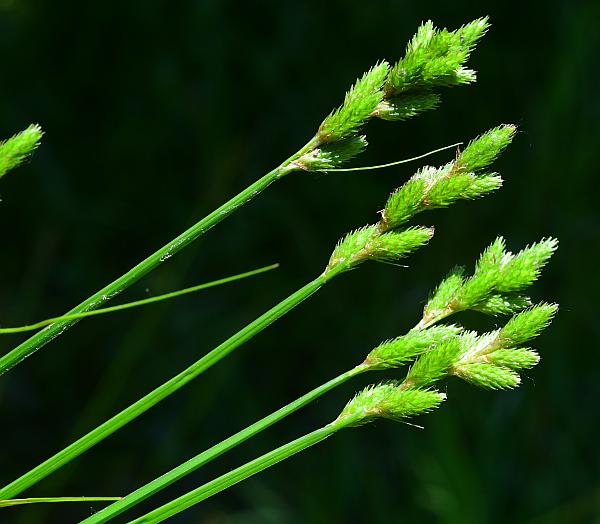Carex normalis Mack.

Native
CC = 4
CW = -3
MOC = 80
© SRTurner
Carex normalis Mack. | |
 |
Native CC = 4 CW = -3 MOC = 80 |
© SRTurner |
|
Family - Cyperaceae, Carex section Ovales Habit - Monoecious sedge with short, inconspicuous rhizomes, forming tufts or clumps. Stems - Flowering stems 25-100 cm long, much longer than the leaves. Vegetative stems shorter than the flowering stems and developing late in the season, the leaves clustered near the tip. Leaves - Leaves with well-developed blades mostly 3-7 per flowering stem. Leaf blades 2-30 cm long, 1.5-6.0 mm wide, light green to green. Leaf sheaths extended past the insertion point of the leaf blade, the ventral side thin, white, papery, the tip truncate to somewhat concave, the ligule mostly longer than wide and U-shaped.
Inflorescences - Mostly stiffly erect, the 4-10 spikes densely or less commonly loosely overlapping along the relatively stout and stiff axis, the internode between the lowermost spikes 2.5-11.5 mm long. Spikes 6-9 mm long, 5-8 mm wide, the pistillate portion circular to ovate or obovate in outline, rounded at both ends or the terminal spike tapered to a well-developed, staminate base, this usually inconspicuous in lateral spikes, with 15 to numerous perigynia with ascending or spreading tips.
Perigynia - Scales 2.0-2.9 mm long, shorter and narrower than, but not hidden by the perigynia, ovate, rounded to sharply pointed, white to light yellowish brown, with a green midrib and lighter margins. Perigynia 3.1-4.2 mm long, 1.5-2.0 mm wide, 1.8-2.5 times as long as wide, flat to slightly concave on the ventral side and somewhat convex on the dorsal side, the main body longer than wide, ovate, widest below the middle, broadly winged to the base, tapered to a beak with toothed or roughened margins, the wing extending to the tip of the beak, the ventral and dorsal surfaces lacking papillae, nerveless or finely 5-11-nerved on the ventral surface and finely 3-7-nerved on the dorsal surface, light green to green, sometimes turning straw-colored with age. Fruits 1.5-2.0 mm long, 0.9-1.2 mm wide, oblong-ovate in outline, light yellowish brown.
Flowering - May - July. Habitat - Bottomland forests and prairies, swamps, upland prairies (mostly in moist depressions), fens, margins of ponds, streambanks, pastures, crop fields, ditches, roadsides, and railroads. Origin - Native to the U.S. Lookalikes - C. molesta and several others. Other info. - This sedge is relatively common across Missouri, and also ranges throughout the northeastern quadrant of the U.S. and into Canada. It is a member of the notoriously difficult Ovales section, which contains numerous similar species. C. normalis is characterized by erect spikes containing strongly flattened perigynia. The staminate region is located at the base of the terminal and some lateral spikes and is generally easily observed. The perigynia are broadly winged and translucent around the margins. The species typically grows in moist places. Photographs taken at Riverfront Park, Washington, Franklin County, MO, 6-4-2020, and along the Katy Trail near Dutzow, Warren County, MO, 6-6-2020 (SRTurner). |